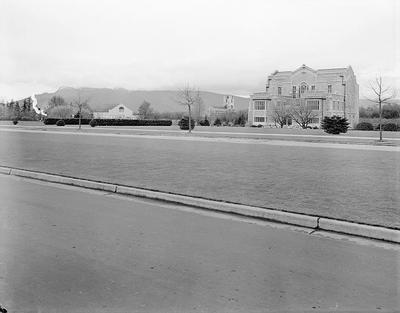[This is an expanded version of an article originally published in Alumni UBC’s Grad Gazette in 2010]
Before The Pit, the Gallery Lounge, Koerner’s Pub, or any of the other popular student retreats on or around the UBC campus… there was The Dolphin.
The Dolphin Tea House was located on Marine Drive, across from what is now Totem Park at the foot of Agronomy Road. It began as a road-side stop first listed in Henderson’s Directory in 1929 as the Marine Pergola Tea Room and Service Station. Former UBC Department of Economics faculty member Anthony Scott described its origins in detail:
The [Vancouver] parks board cut off a big curve of Marine Drive. An entrepreneur set up tables along the fence, and people going for a drive along Marine Drive could have afternoon tea there. A pergola was built over much of the former road (a vine-covered trellis-work, making it a little like a flowery tunnel). The view seaward was great.
They built a central kitchen/building of some kind, so that the “pergola” ran north and south from it.

Advertisement for the Marine Pergola (The Ubyssey, 18 November 1932)
Almost from the beginning, the management aimed to attract clientele from the University community – as the advertisement to the right demonstrates. It appears that by 1932 the “central kitchen” described by Dr. Scott had been expanded to allow indoor dining and dancing.
According to Henderson’s Directory, in 1936 the Marine Pergola was re-named Jubilee Park, presumably for either the City of Vancouver’s golden jubilee that year, or the silver jubilee of King George V the year before. By then the establishment was developing quite the high profile. An article in The Ubyssey of 25 September 1936 quoted proprietor Walter Banner regarding a visit by a leading Hollywood actor: “So delighted was Warner Baxter [‘The Cisco Kid’] and his family with the loveliness of the surroundings when here this summer that they spent an entire afternoon in the park”. An advertisement a few pages further along read:
The prettiest and most unique pleasure park around Vancouver . . . charming tea room . . . a floor large enough to really dance on . . . tea tables outside under grape arbors . . . good home-cooked food that is unsurpassed.
MAKE THE JUBILEE PARK YOUR PARTY HEADQUARTERS IN 1936-37
Several weeks later, the column “Random Ramblings” testified to Jubilee Park’s increasing popularity among students, in a style reminiscent of P.G. Wodehouse:
Today’s offering is born out of a mellow, not very fertile mood, the product of a combination of October sunlight, Strauss waltzes and a cut of freshly baked apple pie under the golden grape-vines of Jubilee Park. Fortified with the pie, and the thought of doing nothing but watch the sunny stretches of the Gulf for a whole hour, one can regard the thorny patches of the primrose path with something approaching kindliness and detachment. (The Ubyssey, 13 October 1936)
The grape-vines growing in the arbour around the patio – supposedly 100 yards long – gave the establishment its nickname, “The Vinery”. Its popularity was already such that rumours later that fall of its impending closure supposedly caused “great sorrow on the campus” – “students are hanging their heads in sadness…. Truly, all should weep”, wrote another Ubyssey columnist in November.
Jubilee Park a.k.a. the Vinery didn’t close, but over the 1937 summer break there was a change of ownership. The Directory listed Mr. and Mrs. Robert Harwood and Miss H.D. Darling as the new operators. There was also a name-change, announced in “Random Ramblings”:
In case you’re finding the Caf pandemonium a little too much for the old high blood pressure, we suggest you drop down to the Vinery – pardon, the Dolphin Tea House – one of these days for lunch…. Under new management, the place has gone right wing. Lawns are cut, the dance floor is gone, and the once Spartan interior is full of antiques, old prints, bric-a-brac and good breeding. We counted five natty waitresses rushing politely about…. (The Ubyssey, 24 September 1937)

Looking out from the patio at The Dolphin (from The Totem, 1939, p. 38)
According to UBC alumnus and theatre instructor Norman Young, the name was inspired by an antique dolphin figurine that the Harwoods brought back from a trip to Europe. When they bought the Tea House, the dolphin was installed on the front door as a door-knocker.
For the next two years the Dolphin was featured regularly in the social pages of UBC’s student newspaper. Business was good enough to warrant building a second floor and expanding the kitchen and dining room. The Tea House was touted as the ideal place for students to relax with tea or coffee, meet a professor after classes, or host private dance parties. It became a favourite venue for everything from bridge parties to society dinners. The quality of the Dolphin’s menu was enough to rate an entry in Duncan Hines’ Adventures in Good Eating – the only restaurant in Vancouver to be included in the guide’s 1937 edition. According to “Shopping with MaryAnn”,
The Dolphin Tea House is like the prize at the end of the rainbow . . . a nice cosy haven at the end of a brisk walk through the autumn leaves along the windy road . . . for at the sign of the Dolphin one can get the most delicious Vienna coffee . . . in a tall glass and topped with a spot of whipped cream . . . and when the fog is clutching at your tonsils with undulating fingers . . . then is the time for consomme with sherry soup, chicken a la king and your favorite dessert…. (The Ubyssey, 20 October 1939)
After 1939 the Dolphin never enjoyed such a high profile in the student newspaper’s pages. The Second World War curtailed both clientele and business hours, and it shut its doors around 1942, reverting to a private residence. However, Norman Young remembers that the Harwoods still rented out the dining room for private functions – the UBC Players’ Club, for example, held most of its social events there.

The Dolphin Tea House (postcard, n.d.)
In 1947 the Tea House reappeared in the Directory under a slightly-different name, The Dolphins – Mrs. E.A. Shirlaw was listed as the manager. The following year W.O. Ivey was listed as the proprietor, and management continued to change every few years afterward as the Tea House struggled to re-capture its pre-war popularity.
Through the late 1940s and 1950s The Dolphins also became the focus of occasional efforts to bring a pub or similar liquor-serving establishment to UBC. The first such attempt came in 1948 when the campus branch of the Royal Canadian Legion proposed turning it into a “wet canteen” for its members. Their plan never went forward, due to a lack of funds and the difficulty in obtaining a liquor license.
The gradual loosening of provincial liquor laws during this period would occasionally inspire editorials in The Ubyssey in favour of turning The Dolphins into an English-style country pub:
The westering sun shining through one’s glass, the crackle of the fire reassuring to one’s ears, the quiet and delightful conversation of, what is so unusual in a Vancouver drinking establishment, a human who does not have to shout in one’s ear to make himself heard…. Quiet feet on the rug, walking through the shaft of sunlight that pours through the leaded windows, a waiter appearing discreetly at your elbow. “Your pleasure, sir?” “Four here, please, and another four for those interesting young ladies in the corner seat.” (The Ubyssey, 16 October 1957)
One main obstacle to such proposals was the opposition of the UBC Senate to liquor sales on or near the campus. Another issue was The Dolphins’ physical location, west of Marine Drive – not actually on the campus, but in Marine Drive Foreshore Park, which was property of the Vancouver Park Board and so not eligible for a liquor license.
The Dolphins continued to operate through the 1950s, serving as a social gathering place for students and faculty and hosting events such as a luncheon during the 1956 B.C. Academy of Science conference. However, it faced increasing competition from new, more conveniently-located eating and social establishments such as the Faculty Club and the Bus Stop Café.
The last reference to the Tea House in The Ubyssey was in March 1960: a simple classified ad, looking for information regarding a road accident nearby. By this time, according to Henderson’s Directory Mr. and Mrs. S.E.B. Avefjall were the managers, under contract to the Park Board. The following year the property was taken over by UBC, and the building was demolished to make room for the First Nations wood-carving activities at Totem Park. Today, all that remains of The Dolphin(s) Tea House is its parking lot, located just south of Wreck Beach Trail 6 and administered as part of Pacific Spirit Regional Park.
Sources:









